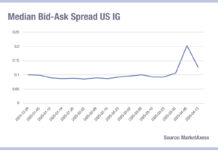European bond market participants are keen to know which post-trade data reporter, known as an approved publication arrangement (APA), has ‘data quality issues’ resulting in the European Securities and Markets Authority (ESMA), EU’s financial markets regulator and supervisor, being unable to publish a quarterly report.
The November results of the quarterly assessment of bond liquidity and the systematic internaliser (SI) regime data for bonds, have been suspended “due to data quality issues with an APA” according to ESMA.
ESMA reports it is following up to ensure a prompt resolution of the issue ahead of the next publication in February 2023.
However, there are concerns amongst buy- and sell-side firms. Traders on both sides use the ESMA data as a benchmark for various metrics. ESMA, and all report trades via various APAs.
At present it is unclear if the “data quality issues” are new, or if they extend to historical reports published by the APA.
For firms who have used the APA to report their own trades as mandated under the 2018 revised Markets in Financial Instruments Directive (MiFID II) and Markets in Financial Instruments Regulation (MiFIR), there will be questions as to whether any of their regulatory obligations have been breached.
There must also be questions asked about the accuracy of historical reports around bond market liquidity. If trading and risk models have incorporated this data into their models, they may be inaccurate, and it is currently unclear by how much or over which periods.
A more immediate outcome of this, in line with Q&A 10 of section 4 of the MiFID II transparency Q&As, is that all bonds for which no liquidity assessment has been published should be deemed “illiquid” as from 16 November 2022 until the application of the next liquidity assessment and ESMA will resume the publications as of 1 February 2023 covering data from 1 October to 31 December 2022.
Every quarter, by the first calendar day of February, May, August and November, ESMA publishes the denominators to be used for the performance of the systematic internaliser (SI) test, which constitutes the total number of transactions and total turnover executed in the financial instrument/class of financial instruments in the EU.
ESMA cannot perform the publication of the SI calculations for bonds on 1 November 2022 due to the problematic APA.
In consequence, investment firms will not need to perform the SI-test for bonds until ESMA publishes the results of the next SI-calculations on 1 February 2023, and the mandatory SI regime will not apply from 15 November 2022 to 14 February 2023. Nevertheless, investment firms can continue to opt into the SI-regime for all financial instruments.
The SI-calculations will be resumed at the next regular publication date, i.e. on 1 February 2023 based on an observation period from 1 July to 31 December 2022, and investment firms will be required to perform the SI determination by 15 February 2023.
ESMA has reminded reporting entities of their obligations to continue reporting transparency data also in the absence of the November publications in order to ensure that the transparency data covers trading activity necessary for the next publications.
The publication of trading venues with the highest turnover for bonds, which is used for Central Securities Depositary (CSDR) cash penalties calculation, that includes information on the trading venue that recorded the highest volume traded for each bond instrument, will be made available by 1 November, as planned. Given that computations are based on trading venue data only, ESMA notes this publication is not affected by the above-mentioned quality issues, detected in the reporting of the APA.
©Markets Media Europe 2025

























